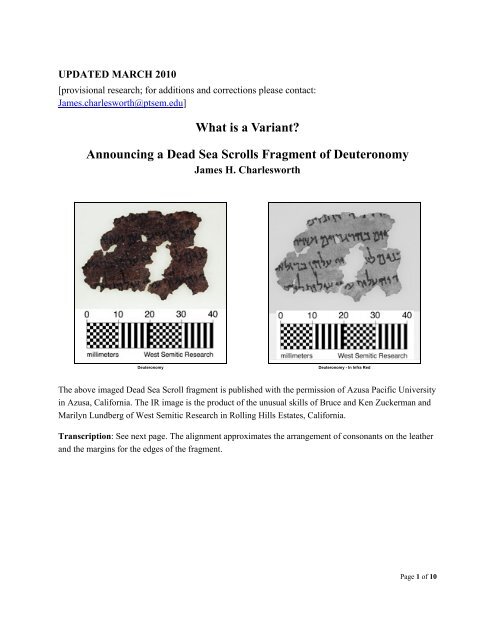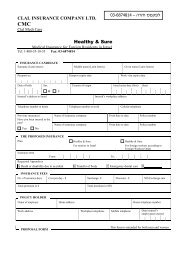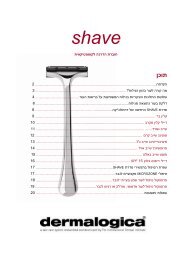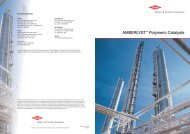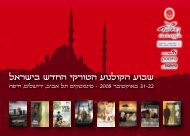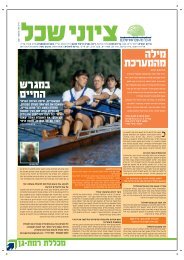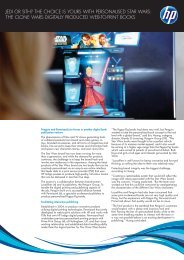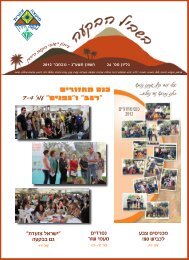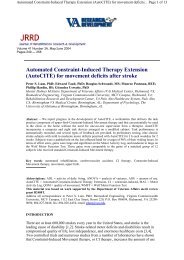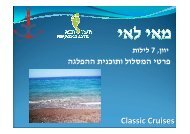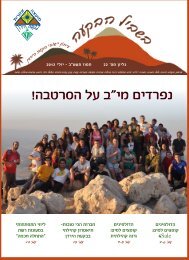What is a Variant? Announcing a Dead Sea Scrolls Fragment of ...
What is a Variant? Announcing a Dead Sea Scrolls Fragment of ...
What is a Variant? Announcing a Dead Sea Scrolls Fragment of ...
You also want an ePaper? Increase the reach of your titles
YUMPU automatically turns print PDFs into web optimized ePapers that Google loves.
UPDATED MARCH 2010<br />
[prov<strong>is</strong>ional research; for additions and corrections please contact:<br />
James.charlesworth@ptsem.edu]<br />
<strong>What</strong> <strong>is</strong> a <strong>Variant</strong>?<br />
<strong>Announcing</strong> a <strong>Dead</strong> <strong>Sea</strong> <strong>Scrolls</strong> <strong>Fragment</strong> <strong>of</strong> Deuteronomy<br />
James H. Charlesworth<br />
Deuteronomy Deuteronomy - In Infra Red<br />
The above imaged <strong>Dead</strong> <strong>Sea</strong> Scroll fragment <strong>is</strong> publ<strong>is</strong>hed with the perm<strong>is</strong>sion <strong>of</strong> Azusa Pacific University<br />
in Azusa, California. The IR image <strong>is</strong> the product <strong>of</strong> the unusual skills <strong>of</strong> Bruce and Ken Zuckerman and<br />
Marilyn Lundberg <strong>of</strong> West Semitic Research in Rolling Hills Estates, California.<br />
Transcription: See next page. The alignment approximates the arrangement <strong>of</strong> consonants on the leather<br />
and the margins for the edges <strong>of</strong> the fragment.<br />
Page 1 <strong>of</strong> 10
------------------------------------<br />
1<br />
1 MT and 4QDeut f : .<br />
2 SP: ( ) ; MT (and St. Petersburg Codex; Aleppo<br />
Codex begins at Deut 28:7): ; LXX: ;<br />
Peshitta: . In Targum Onkelos: .<br />
3 Tear in the leather.<br />
4 MT: ; many MT and SP texts also have .<br />
5 MT and 4QDeut f : . Note most likely the long form <strong>of</strong><br />
the personal suffix, as <strong>of</strong>ten in the Temple Scroll 48:7, 10;<br />
53:8; 54:16; 55:10, 14; 60:21; 63:8.<br />
6 SP and MT: . Note the use <strong>of</strong> matres lection<strong>is</strong> in th<strong>is</strong><br />
line.<br />
Pentateuch <strong>Fragment</strong><br />
Deut 27:4 b -6<br />
] [ ] 1 [ 1<br />
] 2 [ 2<br />
] 4 3 [ ] [ 3<br />
] 6 5 [ 4
Codicology: width: circa 38 millimeters, four lines <strong>of</strong> text, black ink on brown leather, holes, especially a<br />
tear from above line three through line four. There are no v<strong>is</strong>ible margins and no horizontal or vertical<br />
lining v<strong>is</strong>ible. There <strong>is</strong> no writing on the back. There <strong>is</strong> no div<strong>is</strong>ion indicated before the beginning <strong>of</strong><br />
verse six (end <strong>of</strong> line three).<br />
Date: The fragment <strong>is</strong> too small to be cut for AMS C-14 analys<strong>is</strong>. While there are few consonants, one<br />
can judge the work to be mostly in a late Hasmonean Book Hand.<br />
Palaeography: The scribal hand represents archaic forms that can be dated perhaps to 175 BCE and later<br />
forms that date from around 50 and even conceivably to 30 BCE (but we cannot ascertain when such<br />
forms first appeared). 1<br />
alep: three examples. In line three there are two examples. The second alep has two strokes and a<br />
straight left leg as in the late Hasmonean book hand <strong>of</strong> c. 50 BCE (it <strong>is</strong> strikingly similar to<br />
4QEn g ar [4Q212] and similar to 4QSam a and 1QIsa b ). The first alep <strong>is</strong> difficult to date but <strong>is</strong><br />
much older. It seems semicursive and idiosyncratic; it <strong>is</strong> written with a line that begins on the top<br />
left and curves downward to the right, two strokes (one to the top right and one to the bottom left<br />
complete the form); the form <strong>is</strong> remin<strong>is</strong>cent <strong>of</strong> the Nash Papyrus (c. 150 BCE).<br />
bet: four examples, two strokes, concave top, sloping lower horizontal line (similar to 4QSam a<br />
and 1QIsa b ).<br />
gimel: one example, two strokes, bent initial vertical line (as in 4QSam a and 1QIsa b ).<br />
dalet: two examples, two strokes, squared tops (as in 4QSam a and 1QIsa b ).<br />
he: eight examples (not identical forms), two or three strokes, thick horizontal line that sometimes<br />
extends to the left with higher right shoulder (as in the Hasmonean Script <strong>of</strong> c. 125-100 BCE; cf.<br />
4QDeut e and 1QIsa a ).<br />
yod: nine examples.<br />
waw: seven examples.<br />
waw and yod: the waw <strong>is</strong> <strong>of</strong>ten longer, but both have a triangular head (as in 4QSam a and 1QIsa b ).<br />
lamed: seven examples; one stroke. It begins above the imaginary line at the top, descends to<br />
form a flat horizontal line to the right, and curves downward. The form <strong>is</strong> similar to the<br />
palaeography <strong>of</strong> 4QSam a and 1QIsa b (it continues in the later 1QM).<br />
mem: four examples, three are in final form; two forms, similar to 1QIsa b .<br />
Page 3 <strong>of</strong> 10
‘ayin: four examples that are different, two strokes showing a full form (not the small ‘ayin <strong>of</strong><br />
earlier scripts), curved and sloping initial stroke as in 4QSam a and 1QIsa b (but also similar to<br />
4QDeut e and 1QIsa a ).<br />
resh: three examples, a d<strong>is</strong>tingu<strong>is</strong>hing consonant with one flowing curved stroke as in the<br />
Hasmonean semiformal script <strong>of</strong> c. 175-125 BCE (slightly later than 4QQoh a ).<br />
śin: one example, three strokes, curved right vertical form as in the Hasmonean Script<br />
(somewhere between 4QDeut e or 1QIsa a and the later 4QSam a and 1QIsa b ).<br />
taw: four examples which are not identical. The final example has two strokes; the first horizontal<br />
stroke curves downward and a second stroke begins above the first and descends and curves to<br />
the left, as in 4QDeut e and 1QIsa a . 2<br />
It <strong>is</strong> conceivable that an old scribe, using archaic forms learned or seen in h<strong>is</strong> youth, copied th<strong>is</strong> text<br />
sometime shortly after the middle <strong>of</strong> the first century BCE.<br />
The scribe uses a mixture <strong>of</strong> scriptio continua and separated words. V<strong>is</strong>ible are examples <strong>of</strong> final forms:<br />
three instances <strong>of</strong> a final mem, two <strong>of</strong> a final nun, and one <strong>of</strong> a final pe. The waw and yod along with the<br />
resh and dalet show d<strong>is</strong>tingu<strong>is</strong>hable features for dating. Against both so-called SP and MT, the author<br />
employs scriptio plena in line four: תולוע. Thus, in contrast to the biblical manuscripts found at Masada,<br />
our scribe did not observe the prescribed norms for copying a sacred book (bShabbat 103a-105a). 3<br />
Provenience: The Arab who formerly owned the fragment belongs to the family through whom the <strong>Dead</strong><br />
<strong>Sea</strong> <strong>Scrolls</strong> have come to scholars. He claims it <strong>is</strong> from Qumran Cave IV. The fragment appears to be<br />
genuine for the following reasons: The source <strong>is</strong> the same as that for almost all the Qumran fragments in<br />
the Shrine <strong>of</strong> the Book. The patina sparkles in the ink and in the leather. My attempts to prove that the<br />
fragment <strong>is</strong> a fake failed. 4<br />
Text: Deut 27:4b-6. The only Qumran fragment that witnesses to Deut 27:1-10 <strong>is</strong> 4QDeut f Frgs. 32-35;<br />
but it has a lacuna where the mountain (Ebal or Gerizim) would have been mentioned. 5<br />
Translation (line numbers denote the extant line, not the beginning <strong>of</strong> a line):<br />
Line<br />
1 (4) “[when] you [have crossed] the Jo[r]dan, you shall set u[p these stones, about<br />
2 [which I charge you] today, on Mount Gerizim, and coat [them with plaster. (5) And there, you<br />
shall build an altar to the LORD your God, an altar <strong>of</strong>]<br />
3 st]ones. [You must] not wield upon them an iron (tool). (6) [Of unhewn] st[ones you must build<br />
the altar <strong>of</strong> the LORD]<br />
4 your [God], and you shall <strong>of</strong>fer upon it burnt <strong>of</strong>ferings to the LOR[D your God.]”<br />
Page 4 <strong>of</strong> 10
Th<strong>is</strong> text diverges from the MT: “(4) upon crossing the Jordan, you shall set up these stones, about which<br />
I charge you th<strong>is</strong> day, on Mount Ebal, and coat them with plaster. (5) There, too, you shall build an altar<br />
to the LORD your God, an altar <strong>of</strong> stones. Do not wield an iron tool over them; (6) you must build the altar<br />
<strong>of</strong> the LORD your God <strong>of</strong> unhewn stones. You shall <strong>of</strong>fer on it burnt <strong>of</strong>ferings to the LORD your God,<br />
(7)… .” [TANAKH]<br />
Preliminary Reflections: If th<strong>is</strong> copy <strong>of</strong> Deuteronomy <strong>is</strong> indeed from a Qumran Cave, then we have<br />
additional evidence <strong>of</strong> the importance <strong>of</strong> th<strong>is</strong> biblical book at Qumran. The three books most popular at<br />
Qumran, according to stat<strong>is</strong>tics, are the Psalms (37 mss), Deuteronomy (30 mss [not counting the present<br />
fragment and the massive re-writing <strong>of</strong> Deuteronomy in the Temple Scroll]), and Isaiah (21 mss [but there<br />
are some fragments not yet announced]). When one recognizes that Deuteronomy <strong>is</strong> the only book in the<br />
Pentateuch that claims prec<strong>is</strong>ely that it <strong>is</strong> a record <strong>of</strong> Moses’ laws (viz., Dt 1:5; 4:8), gives prominence to<br />
the Torah (Law) and its interpretation, and mentions God’s covenant with Israel 26 times, one can readily<br />
comprehend why the scroll was popular to the Qumranites who stressed the interpretation <strong>of</strong> Torah (esp.<br />
in the Pesharim) and God’s “New Covenant” with them alone.<br />
Text Type: Either Samaritan Pentateuch (unlikely) or Text with the Original Reading (likely). The<br />
fragment preserves four variants to the so-called MT [see transcription and notes].<br />
Two categories should be d<strong>is</strong>tingu<strong>is</strong>hed: <strong>Fragment</strong>s <strong>of</strong> the Samaritan Pentateuch and fragments <strong>of</strong> Pre-<br />
Samaritan manuscripts. One should d<strong>is</strong>tingu<strong>is</strong>h between a copy <strong>of</strong> the Samaritan Pentateuch and Old<br />
Readings (known in the Samaritan Pentateuch and reflected <strong>of</strong>ten in the LXX and elsewhere) that appear<br />
in pre-70 Hebrew <strong>Scrolls</strong>. Hence, “Proto-Samaritan Texts” should be defined as manuscripts preserving<br />
textual traditions that are not caused by Samaritan editing and appear not only in the Samaritan<br />
Pentateuch but also in some Qumran biblical manuscripts, namely 4QpaleoExod m , 6 4QNum b , 7 4Q158,<br />
and 4Q364. 8 These manuscripts are not portions <strong>of</strong> the Samaritan Pentateuch, because they do not contain<br />
the striking Samaritan features <strong>of</strong> the Pentateuch.<br />
The close relation between the Samaritan Pentateuch and the received Pentateuch (the so-called MT) –<br />
especially in textual tradition and sense div<strong>is</strong>ions – indicates that the Samaritans and Judeans (and<br />
conceivably some Jews in Lower Galilee) separated late (perhaps during, or after, the time <strong>of</strong> John<br />
Hyrcanus). The study <strong>of</strong> the transm<strong>is</strong>sion <strong>of</strong> the Pentateuch indicates that Samaritans and other early Jews<br />
shared an early stage <strong>of</strong> traditions and Scripture. We should keep in focus the possibility that a manuscript<br />
with a reading found in the Samaritan Pentateuch may not be the result <strong>of</strong> editing by Samaritans; it may<br />
represent the original reading. Thus, the MT and other related text types may represent redaction by<br />
others, notably Jews in Judea, especially after the burning <strong>of</strong> the Samaritan “altar” by John Hyrcanus in<br />
the late second century BCE.<br />
How are we to d<strong>is</strong>cern the text-type <strong>of</strong> th<strong>is</strong> fragment <strong>of</strong> Deuteronomy? Two hypotheses seem apparent.<br />
First, prima facie, it <strong>is</strong> conceivable that the manuscript <strong>is</strong> a copy <strong>of</strong> the Samaritan Pentateuch. In favor <strong>of</strong><br />
th<strong>is</strong> hypothes<strong>is</strong> are the following four observations: (1) The fragment preserves the reading found in the<br />
Page 5 <strong>of</strong> 10
Samaritan Pentateuch <strong>of</strong> Deut 27:4: One <strong>is</strong> to build an altar on Mount Gerizim. (2) The Samaritans<br />
consider it a commandment (mizwot) to write “Mount Gerizim” with seven letters, as in th<strong>is</strong> fragment<br />
(hrgrzim); and to worship on Mount Gerizim <strong>is</strong> the so-called eleventh commandment in the Samaritan<br />
Decalogue which now appears in early lapidary inscriptions. 9 (3) A study <strong>of</strong> the recently d<strong>is</strong>covered<br />
inscriptions in Samaria, especially on Mount Gerizim, indicates the ex<strong>is</strong>tence <strong>of</strong> a Samaritan community<br />
with priestly institutions, and the preservations <strong>of</strong> the paleo-Hebrew script during the Hellen<strong>is</strong>tic and later<br />
periods. 10 (4) One might then add that it <strong>is</strong> impressive that the scribe wrote bhrgrzim and not bhr grizim.<br />
The scriptio continua clashes with the scribe’s practice <strong>of</strong> separating most words. On Masada, a Paleo-<br />
Hebrew papyrus scroll, inscribed on both sides, preserves [םי]זירגרה; that <strong>is</strong> “Mount Gerizim” appears as<br />
one word. S. Talmon and A. Ben-Tor conclude that a Samaritan, fleeing the Roman armies, probably<br />
bought the scroll to Masada. 11<br />
Are there problems with th<strong>is</strong> hypothes<strong>is</strong>? Yes. First, the spelling <strong>of</strong> “Mount Gerizim” as one word and in<br />
a form with only seven consonants (hrgrzim) <strong>is</strong> clearly a Samaritan practice; the Hebrew form <strong>is</strong> also<br />
mirrored in Greek in the two Delos stelae that pra<strong>is</strong>e the “holy Argarizein.” But, as S. Talmon points out,<br />
the form also appears in scrolls and texts that are not Samaritan: “Agar<strong>is</strong>in” in the Latin <strong>of</strong> 2Mac 5:23 and<br />
6:2, “Argarizin” in Josephus’ War 1.6, “Mons Agrar<strong>is</strong>” 12 in Pliny’s Natural H<strong>is</strong>tory (V.14.68). 13 Thus, the<br />
presence <strong>of</strong> th<strong>is</strong> form – one word with seven consonants – does not prove that the scroll <strong>is</strong> a Samaritan<br />
text. 14<br />
Second, it would be surpr<strong>is</strong>ing to find that the Qumran Library, located in eleven caves, preserved copies<br />
<strong>of</strong> the Samaritan Pentateuch. It seems representative to refer to the Qumran <strong>Scrolls</strong> as belonging to a<br />
“Library;” th<strong>is</strong> library contained differing traditions (as in Princeton’s many libraries) and yet <strong>is</strong><br />
characterized by a concentration <strong>of</strong> texts that reflect a d<strong>is</strong>tinct type <strong>of</strong> sectarian Juda<strong>is</strong>m (as most scholars<br />
now conclude, related somehow to the Essenes <strong>of</strong> Philo and Josephus). The Qumran Library <strong>is</strong> selective;<br />
as far as we can d<strong>is</strong>cern, it contained neither a copy <strong>of</strong> texts that are clearly pro-Hasmonean (as with 1<br />
Mac) nor a copy <strong>of</strong> the Phar<strong>is</strong>aic-like Psalms <strong>of</strong> Solomon. 15 Third, as already stated Samaritan Texts<br />
should not be confused with Proto-Samaritan texts; as far as I know, the only scholar who argued that<br />
fragments <strong>of</strong> the Samaritan Pentateuch were found at Qumran <strong>is</strong> M. Baillet. 16 Such fragments seem to be<br />
Proto-Samaritan text types.<br />
The second hypothes<strong>is</strong> <strong>is</strong> markedly different. The original reading <strong>of</strong> Deuteronomy, “on Mount Gerizim,”<br />
<strong>is</strong> preserved in th<strong>is</strong> fragment. 17 Thus, it should not be labeled “a variant;” the MT and related texts<br />
preserve the “variant” and it looks redactional and later. Here are the reasons for th<strong>is</strong> suggestion.<br />
1) Most importantly, the text <strong>of</strong> Deuteronomy mentions two mountains: the Mountain <strong>of</strong> the Curse or<br />
Ebal and the Mountain <strong>of</strong> Blessing or Gerizim: “You shall pronounce the blessing at Mount Gerizim and<br />
the curse at Mount Ebal” (Deut 11:29 TANAKH). One would expect, therefore, that the author or<br />
compiler <strong>of</strong> Deuteronomy wrote that Moses conveyed the instruction to build God’s altar on Mount<br />
Gerizim and not Mount Ebal as in the MT and LXX text <strong>of</strong> Deut 27:4 18 (which influenced the Vulgate,<br />
Syriac, and Coptic traditions). 19 Moreover, just a few lines later we hear the following: “After you have<br />
Page 6 <strong>of</strong> 10
crossed the Jordan … stand on Mount Gerizim when the blessing for the people <strong>is</strong> spoken” (Deut 27:11<br />
TANAKH). One would have expected the author or compiler <strong>of</strong> Deuteronomy to have quoted Moses as<br />
exhorting the building <strong>of</strong> an altar (27:5) on Mount Gerizim (as in th<strong>is</strong> fragment) and not on Mount Ebal<br />
(as in the MT and related texts).<br />
2) Sacred texts <strong>of</strong>ten refer to specific locations as hallowed; scribes who copied these passages sometimes<br />
lived and worked among Jews who challenged (or even rejected) the honor bestowed on the place<br />
mentioned. These scribes might have assumed that the correct reading may not be in a manuscript<br />
available for copying. They certainly knew about numerous versions <strong>of</strong> a biblical book and might have<br />
imagined the reading they wanted was in one <strong>of</strong> them. Regarding the reading in our fragment <strong>of</strong><br />
Deuteronomy, after John Hyrcanus destroyed the Samaritan places <strong>of</strong> worship on Mount Gerizim, it <strong>is</strong><br />
conceivable that a Jew, especially one in Judea, in the middle <strong>of</strong> the first century BCE – or less than one<br />
hundred years after Hyrcanus’ destruction <strong>of</strong> the buildings on Mount Gerizim about 112 BCE 20 – would<br />
have thought that Moses had intended to have God’s altar built on Mount Ebal and not on the Samaritan’s<br />
Mount Gerizim which lay in ruins and belonged to the Samaritans. Copying scribes in Judea, and<br />
especially in Jerusalem, would have copied Deuteronomy in the first century BCE with a hatred <strong>of</strong><br />
Samaritans. Perhaps the copy<strong>is</strong>t even imagined that the Samaritans were not “Jews” but belonged to the<br />
“many nations” that were to be obliterated from the Holy Land. He may have thought that God ordered<br />
their “altars” to be destroyed (Deut 7:1-5). 21 Th<strong>is</strong> speculation <strong>is</strong> supported by the vast evidence <strong>of</strong><br />
numerous text types <strong>of</strong> biblical texts that circulated in the late first century BCE; each text type was<br />
probably deemed sacred by the circle <strong>of</strong> those who heard the text. Our scribe may not have seen “Mount<br />
Ebal” in h<strong>is</strong> exemplar or copies but he may well have imagined that th<strong>is</strong> meaning must have been implied<br />
by the author <strong>of</strong> Deuteronomy.<br />
For at least fifty years, scholars have stated that before 70 CE copying scribes did not consider the<br />
Hebrew text <strong>of</strong> Scripture to be unalterable, because the text’s consonantal form was still fluid. 22 Copying<br />
scribes altered the text in good faith in the attempt to restore the correct reading and to remove<br />
possibilities <strong>of</strong> m<strong>is</strong>understanding. They sought to serve the circle <strong>of</strong> Jews for whom the copy was<br />
intended. I suggest that our fragment preserves the original reading and indicates that the MT and related<br />
textual traditions reflect alterations.<br />
3) To me, th<strong>is</strong> second hypothes<strong>is</strong> <strong>is</strong> persuasive, indeed confirmed, because <strong>of</strong> the reading <strong>of</strong> the Old Latin:<br />
garzin (Latin Cod. 100). 23 It <strong>is</strong> unlikely that the Old Latin <strong>is</strong> dependent on the Samaritan Pentateuch. It <strong>is</strong><br />
conceivable that a Latin scribe knew the Tendenzen <strong>of</strong> Deuteronomy and changed the text. It <strong>is</strong> more<br />
likely, however, that the Old Latin reading derives from a lost Greek manuscript or even a Semitic<br />
manuscript (perhaps like the one now announced). 24 In any case, the reading <strong>of</strong> Old Latin Codex 100<br />
seems to clinch the argument that our manuscript preserves the original reading and <strong>is</strong> not a portion <strong>of</strong> the<br />
Samaritan Pentateuch. Most likely the Samaritans followed an old reading that originated in the North and<br />
<strong>is</strong> Samarian (not Samaritan). All <strong>of</strong> us need to reconsider what we mean by “Samaritan,” “Proto-<br />
Page 7 <strong>of</strong> 10
Samaritan,” and similar terms; the “new” fragment challenges us to improve our perceptions <strong>of</strong> tensions<br />
between Judeans and Samaritans and to refine our nomenclature. 25<br />
Of interest to Chr<strong>is</strong>tians <strong>is</strong> Jesus’ comment in the Gospel <strong>of</strong> John: “Jesus said to her, ‘Woman, believe<br />
me, the hour <strong>is</strong> coming when you will worship the Father neither on th<strong>is</strong> mountain nor in Jerusalem’” (Jn<br />
4:21 NRSV). Jesus <strong>is</strong> speaking to a Samaritan woman in Samaria at Jacob’s well which <strong>is</strong> near Mount<br />
Gerizim and Mount Ebal. 26<br />
1 The script <strong>is</strong> not similar to the Aramaic script <strong>of</strong> the Mount Gerizim Inscriptions; see the chart <strong>of</strong> these inscriptions<br />
in J. Dušek, “Ruling <strong>of</strong> Inscriptions in Hellen<strong>is</strong>tic Samaria,” MAARAV 14.2 (2007) 43-65; see esp. pp. 46-47.<br />
2 Our fragment cannot be a portion <strong>of</strong> 4QDeut e ; the scribal hands are very d<strong>is</strong>similar.<br />
3 Though they date from the same period, our text <strong>of</strong> Deuteronomy <strong>is</strong> d<strong>is</strong>similar to the copy <strong>of</strong> Deut 33:17-34:6<br />
found on Masada; and the Masada Deuteronomy <strong>is</strong> identical to the MT. Amnon Ben-Tor, Back to Masada<br />
(Jerusalem: Israel Exploration Society and Washington: Biblical Archaeology Society, 2009) see esp. pp. 190-94<br />
and Fig. 184.<br />
4 I spoke with Bruce and Ken Zuckerman; they agree with me that the fragment <strong>is</strong> similar to the authentic fragments.<br />
5 See J.A. Duncan in E. Ulrich, F.M. Cross, et al., Qumran Cave 4.VII: Genes<strong>is</strong> to Numbers, p. 53 and Plate XV.<br />
Also, see E. Ulrich, The Biblical Qumran <strong>Scrolls</strong> (Supplements to Vetus Testamentum 134; Leiden, Boston: Brill,<br />
2010) p. 227.<br />
6 See J.E. Sanderson, An Exodus Scroll from Qumran: 4QpaleoExod m and the Samaritan Tradition (Harvard Semitic<br />
Studies 30; Atlanta: Scholars Press, 1986) and P.W. Skehan, E. Ulrich, and J.E. Sanderson, with P.J. Parsons<br />
Qumran Cave 4.IV: Palaeo-Hebrew and Greek Biblical Manuscripts (DJD 9; Oxford: Clarendon Press, 1992) pp.<br />
53-130.<br />
7 See N. Jastram in E. Ulrich, F.M. Cross, et al., Qumran Cave 4.VII: Genes<strong>is</strong> to Numbers (DJD 12; Oxford:<br />
Clarendon Press, 1994) pp. 205-67. Also, see Jastram, “A Compar<strong>is</strong>on <strong>of</strong> Two ‘Proto-Samaritan’ Texts from<br />
Qumran: 4QpaleoExod m and 4QNum b ,” <strong>Dead</strong> <strong>Sea</strong> D<strong>is</strong>coveries 5 (1998) 264-89.<br />
8 I am grateful to J. Dušek for helping me refine th<strong>is</strong> aspect <strong>of</strong> my research. Most likely 4QDeut n <strong>is</strong> not to be<br />
included among the Proto-Samaritan Texts, because the method <strong>of</strong> interpolation differs from that in the SP. See E.<br />
Owen, “4QDeut n : A Pre-Samaritan Text,” <strong>Dead</strong> <strong>Sea</strong> D<strong>is</strong>coveries 4 (1997) 162-78.<br />
9 See F. Dexinger, “Das Garizimgebot im Dekalog der Samaritaner,” in Sudien zum Pentateuch: Walter Kornfeld<br />
zum 60. Geburtstag, edited by G. Braulik (OSB; Vienna, Freiburg, Basel: Herder, 1977) pp. 111-33. Also, see G.<br />
Braulik, Die deuteronom<strong>is</strong>chen Gesetze und der Dekalog (Stuttgart: Verlag Kathol<strong>is</strong>ches Bibelwerk, 1991).<br />
10 See J. Dušek, MAARAV 1.2 (2007) 43-65; and esp. pp. 64-65.<br />
11<br />
S. Talmon, Hebrew <strong>Fragment</strong>s from Masada (Masada VI; Jerusalem: Israel Exploration Society and the Hebrew<br />
University <strong>of</strong> Jerusalem, 1999) p. 146. Ben-Tor, Back to Masada, p. 208.<br />
Page 8 <strong>of</strong> 10
12 Pliny must not have known the meaning <strong>of</strong> the nomen proprium, since he adds “mons.”<br />
13 S. Talmon, Hebrew <strong>Fragment</strong>s from Masada, p. 146.<br />
14 See R. Pummer, “!C'!C3-3;: A Criterion for Samaritan Provenance?” Journal for the Study <strong>of</strong> Juda<strong>is</strong>m 18<br />
(1987) 18-25. I am grateful to J. Dušek for drawing my attention to th<strong>is</strong> important publication by one <strong>of</strong> the leadings<br />
scholars on the Samaritans.<br />
15 H. Eshel and E. Schuller both have identified anti-Samaritan passages in writings found at Qumran. See H. Eshel,<br />
“Prayer <strong>of</strong> Joseph from Qumran,” Zion 56 (1991) 134-35. And E. Schuller, “4Q372:I: A Text About Joseph,” RQ 14<br />
(1990) 349-76. The Qumranites were clearly anti-Hasmonean; given their origins in the Jerusalem Temple, many <strong>of</strong><br />
them may have been anti-Samaritan.<br />
16 Emanuel Tov confirms my opinion (viva voce). See M. Baillet: “certain Qumran manuscripts contain not only<br />
intermittent Samaritan elements but the Samaritan text itself (ma<strong>is</strong> le texte samaritain lui-même).” M. Baillet, “Le<br />
texte samaritain de l’Exode dans les manuscrits de Qumran,” in Hommages à André Dupont-Sommer, edited by A.<br />
Caquot, et al. (Par<strong>is</strong>: Andrien-Ma<strong>is</strong>onneuve, 1971) pp. 363-81; the quotation <strong>is</strong> on p. 380 Again, I am indebted to J.<br />
Dušek and h<strong>is</strong> research that he sent to me. My research <strong>is</strong> deeply indebted to many scholars.<br />
17 Long ago, before the present fragment was known, F. Dexinger (a leading expert in Samaritan studies) opined that<br />
the MT <strong>of</strong> Deut 27:4 was not original and “Mount Gerizim” was the original reading. Now we have evidence <strong>of</strong> that<br />
reading in a Hebrew pre-70 manuscript. See Dexinger in Studien zum Pentateuch, pp. 111-33.<br />
18 In the LXX, the spelling reflects the ‘ayin grapheme. See J.W. Wevers, Notes on the Greek Text <strong>of</strong> Deuteronomy<br />
(SBL Septuagint and Cognate Studies Series 39; Atlanta: Scholars Press, 1995) p. 417.<br />
19 See the apparatus criticus to my transcription. Jerome supplied in monte Hebal; see R. Weber, et al., eds., Biblia<br />
Sacra: Iuxta Vulgatam Versionem (Stuttgart: Württemberg<strong>is</strong>che Bibelanstalt, 1969) p. 270. As expected, the Coptic<br />
follows the Greek; see M.K.H. Peters, An Analys<strong>is</strong> <strong>of</strong> the Textual Character <strong>of</strong> the Bohairic <strong>of</strong> Deuteronomy (SBL<br />
Septuagint and Cognate Studies 9; M<strong>is</strong>soula: Scholars Press, 1979) p. 327.<br />
20 See Y. Magen, H. M<strong>is</strong>gav, and L. Tsfania, Mount Gerizim Excavations (Jerusalem: Israel Antiquities Authority,<br />
2004) vol. 1, p. 13.<br />
21 At Qumran there was some variety; but it was defined by the Community. On Masada much more heterogeneity<br />
prevailed. As Talmon states: “In the face <strong>of</strong> the imminent final attack <strong>of</strong> the Roman army, the barriers between the<br />
various socio-religious groups broke down to a certain extent: members <strong>of</strong> the main-stream community, Zealots,<br />
Sicarii, adherents <strong>of</strong> the ‘Community <strong>of</strong> the Renewed Covenant’, and Samaritans hoped to find safety on Masada.”<br />
Talmon in Masada VI, p. 149.<br />
22 For example, see the reflections by E. Würthwein in The Text <strong>of</strong> the Old Testament (New York: Macmillan, 1957)<br />
p. 74.<br />
23 See the apparatus criticus in J. W. Wevers, ed., Deuteronomium (Septuaginta 3.2; Göttingen: Vandenhoeck &<br />
Ruprecht, 1977) p. 287. Pr<strong>of</strong>essor E. Ulrich rightly states (in an email <strong>of</strong> 8 Aug 08) that the many so-called SP<br />
readings in LXX mss are more widespread than we think, and most are in fact “Jew<strong>is</strong>h.” For the Vetus Latina <strong>of</strong><br />
Deuteronomy, see vol. 4 <strong>of</strong> the Stiftung Vetus Latina (Vetus Latina Institut, D-88631 Beuron).<br />
Page 9 <strong>of</strong> 10
24 Liber Antiquitatum Biblicarum (Pseudo-Philo) was originally composed in Hebrew; the Latin seems to be<br />
translated from Greek, but the many errors and Semit<strong>is</strong>ms may have come directly from a Hebrew manuscript [see<br />
the comments by Harrington in OTP 2.298-99].<br />
25<br />
I am indebted to E. Ulrich for a d<strong>is</strong>cussion on these <strong>is</strong>sues. He drew my attention to G. Knoppers, “Mt. Gerizim<br />
and Mt. Zion,” SR 34 (2005) 309-38.<br />
26 I am pleased to acknowledge insight from many scholars, including E. Tov, E. Ulrich, K. Winslow, and especially<br />
a detailed response to my initial reflections from J. Dušek. I also appreciate the insights <strong>of</strong> Benyamim Tsedaka, the<br />
editor <strong>of</strong> A.B. –The Samaritan News-Weekly.<br />
Page 10 <strong>of</strong> 10


